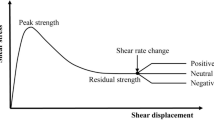Abstract
Residual shear strength is generally used for design and repairs on slopes containing pre-existing shear surfaces in large-scale landslides. Some recent research works suggest that the pre-existing shear surface of a large-scale landslide can regain strength with the passage of time, which should be considered in designing the slope stability measures. In this study, three landslide soils were tested in a ring shear apparatus with rest periods between shear of 1, 3, 7, 15, and 30 days, with the following main objectives (1) to understand the strength recovery behavior of landslide soils in residual state of shear after as long as 30 days of rest between shearing, (2) to understand the comparative pattern of strength recovery in highly plastic and less plastic soils, and (3) to understand the mechanism involved in strength recovery at residual state of shear. The obtained experimental results indicate that the recovery of shear strength in the residual state started to appear slightly after shear was discontinued for 3 days, and was lost immediately after a very small shear displacement. On the other hand, as understood from the experimental work in this study, the trend of strength recovery, is somewhat in increasing order with prolongation of the period that shear is discontinued.
Access this chapter
Tax calculation will be finalised at checkout
Purchases are for personal use only
Similar content being viewed by others
References
Angeli MG, Gasparetto P, Menotti RM, Pasuto A, Silvano S (1996) A visco-plastic model for slope analysis applied to a mudslide in Cortina d’Ampezzo. Q J Eng Geol 29:233–240
Angeli MG, Gasparetto P, Bromhead N (2004) Strength-regain mechanisms in intermittently moving slides. In: Proceedings of the IXth international symposium on landslides, Rio de Janeiro 1. Taylor and Francis, London, pp 689–696
Bhat DR, Bhandari NP, Yatabe R, Tiwari RC (2011) Residual-state creep test in modified torsional ring shear machine: methods and implications. Int J Geomate 1(1):39–43
Bhat DR, Bhandari NP, Yatabe R, Tiwari RC (2012) A new concept of residual-state creep test to understand the creeping behavior of clayey soils. Geocongress 2012:683–692. doi:10.1061/9780784412121.071
Bhat DR, Bhandari NP, Yatabe R (2013a) Effect of shearing rate on residual strength of Kaolin Clay. Electron J Geotech Eng 18(G):1387–1396
Bhat DR, Bhandari NP, Yatabe R (2013b) Residual-state creep behavior of typical clayey soils. Nat Hazards 69:2161–2178. doi:10.1007/s11069-013-0799-3
Bhat DR, Bhandari NP, Yatabe R (2013c) Study of preexisting shear surfaces of reactivated landslides from a strength recovery perspective. J Asian Earth Sci 77:243–253, http://dx.doi.org/10.1016/j.jseaes.2013.08.023
Bhat DR, Bhandari NP, Yatabe R (2013d) Method of residual-state creep test to understand the creeping behaviour of landslide soils. Landslide Sci Pract 2:635–642. doi:10.1007/978-3-642-31445-2_83
Bhat DR, Bhandari NP, Yatabe R (2014) Strength recovery from residual-state of shear on soils. Indian Geotech J 44:94–100. doi:10.1007/s40098-013-0066-2
Bishop AW, Green E, Garge VK, Andresen A, Brown JD (1971) A new ring shear apparatus and its application to the measurement of residual strength. Geotechnique 21(4):273–328
Bromhead EN (1979) A simple ring shear apparatus. Ground Eng 12(5):40–44
Carrubba P, Del Fabbro M (2008) Laboratory investigation on reactivated residual strength. J Geotech Geoenviron 134(3):302–315
Czarnecki J, Dabros T (1980) Attenuation of the van der Waals attraction energy in the particle/semi-infinite medium system due to the roughness of the particle surface. J Colloid Interface Sci 78(1):25–30
D’Appolonia E, Alperstein R, D’Appolonia DJ (1967) Behavior of a colluvial slope. J Soil Mech Found Div 93(4):447–473
Gibo S, Egashira K, Ohtsubo M, Nakamura S (2002) Strength recovery from residual state in reactivated landslides. Geotechnique 52(9):683–686
Mesri G, Castro A (1987) Ca/Cc concept and K0 during secondary compression. J Geotech Eng 113(3):230–247
Mitchell JK, Soga K (2005) Fundamentals of soil behavior, 3rd edn. Wiley, New York
Nakamura S, Gibo S, Yasumoto J, Kimura S, Vithana S (2010) Application of recovered strength in stability analysis of reactivated landslide, Xuechengzhen, China. GeoFlorida 2010:3149–3154
Ramiah BK, Purushothamaraj P, Tavane NG (1973) Thixotropic effects on residual strength of remoulded clays. Indian Geotech J 3(3):189–197
Schmertmann JH (1991) The mechanical ageing of soils. J Geotech Eng 117(12):1288–1330
Skempton A (1964) Fourth rankine lecture: long term stability of clay slopes. Geotechnique 14(2):77–101
Skempton AW (1985) Residual strength of clays in landslides, folded strata and the laboratory. Geotechnique 35(1):3–18
Stark TD, Hussain M (2010) Shear strength in preexisting landslides. J Geotech Geoenviron 136(7):957–962
Stark TD, Choi H, McCone S (2005) Drained shear strength parameters for analysis of landslides. J Geotech Geoenviron 131(5):575–588
Terzaghi K, Peak RB, Mesri G (1996) Soil mechanics in engineering practice, 3rd edn. Wiley, New York
Acknowledgements
The first author would like to acknowledge the Special Graduate Course on Disaster Mitigation Study for Asian Students, Graduate School of Science and Engineering at Ehime University, Japan for funding the project.
Author information
Authors and Affiliations
Corresponding author
Editor information
Editors and Affiliations
Rights and permissions
Copyright information
© 2014 Springer International Publishing Switzerland
About this paper
Cite this paper
Bhat, D.R., Bhandary, N.P., Yatabe, R. (2014).
 Shear Strength Recovery of Clayey Soils Following Discontinuation of Shear at a Residual State.
In: Sassa, K., Canuti, P., Yin, Y. (eds) Landslide Science for a Safer Geoenvironment. Springer, Cham. https://doi.org/10.1007/978-3-319-04999-1_42
Shear Strength Recovery of Clayey Soils Following Discontinuation of Shear at a Residual State.
In: Sassa, K., Canuti, P., Yin, Y. (eds) Landslide Science for a Safer Geoenvironment. Springer, Cham. https://doi.org/10.1007/978-3-319-04999-1_42
Download citation
DOI: https://doi.org/10.1007/978-3-319-04999-1_42
Published:
Publisher Name: Springer, Cham
Print ISBN: 978-3-319-04998-4
Online ISBN: 978-3-319-04999-1
eBook Packages: Earth and Environmental ScienceEarth and Environmental Science (R0)




